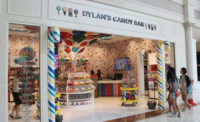Licensed Candy
Hot licenses can sell more candy — but retailers have become much more selective in their ‘picks.’
Overview
While licensed candy isn’t tracked per se,
the overall licensing industry seems to be losing a bit of steam from
decades past. Manufacturers paid $5.9 billion in licensing royalties in
2004, which was a mere 1 percent increase from 2003. In candy, it seems
that more and more retailers are looking for only “the best of the
best” from new and evergreen licenses.
Faced with reduced SKU counts in their programs, many
are finding it most effective to take a stronger position on a handful of
the most popular evergreen and TV licenses (and maybe one
kids’/family movie license a season) rather than carry a broad
assortment of major and minor licensed products all over the board.
That being said, candy is one of the first places a
new license will “make” it, simply because both are high
impulse buys.
Target Audience
Kids are the obvious target audience for licensed
candy. But their fickle nature makes them less than ideal as the focus of
any license with staying power. That’s why moms are emerging as the
primary target of the up and coming “evergreens” of our time:
licensed candy that has a positive nutrition value and/or candy that has a
value-added connotation because of the licensed brand it carries —
such as a juice license.
Thus licensed candy’s latest edge is similar to
other consumable categories that appeal to the moms who buy them: they are
in portion-control packaging, they highlight nutritional/added value and
calorie count is very visible. It seems that when there’s value, moms
don’t mind spending a little bit of extra money for the license.
Pricing/Positioning
Licensed candy is typically found promoted away from
the mainstream candy set at slightly higher price points than its
non-licensed counterparts. The economics of the licensing model are fairly
straightforward in this and other consumables markets: manufacturers pay
licensors an average of 10 percent of the wholesale price, betting that the
increased and incremental sales from a licensed item will more than exceed
that. Retailers pass some of that fee on to the end consumer, but not all
of it — meaning everyone gambles on the success of the license. But a
few cents more is to be expected by consumers and shouldn’t be viewed
negatively by retailers.
Adjacencies
Themed party goods are a natural adjacency for
licensed candy. This appeals to moms and kids when shopping for birthday
party supplies — and means that it will not be necessary for mom to
make an additional shopping stop.
Marketing/Promotion
The opportunity for cross-promotion is huge in
licensed candy. Therefore, it is imperative that candy buyers coordinate
with each department buyer involved with that license. If there is a
promotion going on in one department, it makes a lot of sense for candy
buyers to do tie-ins, or at the very least, to cross-merchandise.
Seasonal Opportunities
The in and out nature of seasonal candy is in perfect
sync with the in and out nature of licensed candy that is tied to a
particular movie, especially if it falls during a holiday. If a movie is
being released in late winter, for instance, Valentine’s Day candy
tie-ins/packaging make a lot of sense — or so it would seem. In
reality, the amount of lead time between idea and rollout is a major risk
for manufacturers and retailers — especially with seasonal licensed
candy. There is no telling a year in advance when a movie will hit the
market. For retailers planning a holiday promotion of a licensed product,
even a slight delay could be devastating. The industry is going to
have to come up with ways that allow for quicker seasonal
opportunities with shorter lead times.
Merchandising Musts
Seek and you shall find . . . the right licenses. Candy
buyers need to establish more of a voice in the licensing community if they
are to be truly successful with the sub-category. It has always been
assumed that it is the responsibility of the various studios, etc. to go
after retail buyers with the latest licenses and draw them in to the
process. Now, forward-thinking retailers are expressing that they want to
be brought into the licensing life cycle much earlier than they currently
are. They are playing a much more active role at the onset of the license.
Water your evergreens. Cross-merchandising
and promotion is the best way to develop higher-than-average sales with
evergreen licenses. Regularly add “new life” to older favorites
with endcap promotions that may or may not incorporate other departments.
Licensed seasonal displays that are created in-store can capitalize on the
consumers’ need for moderately priced gift items throughout the year.

